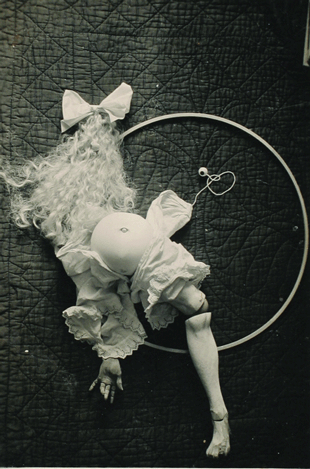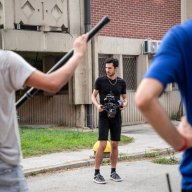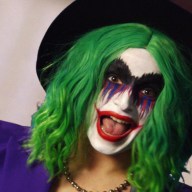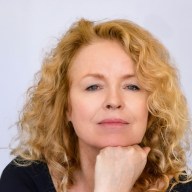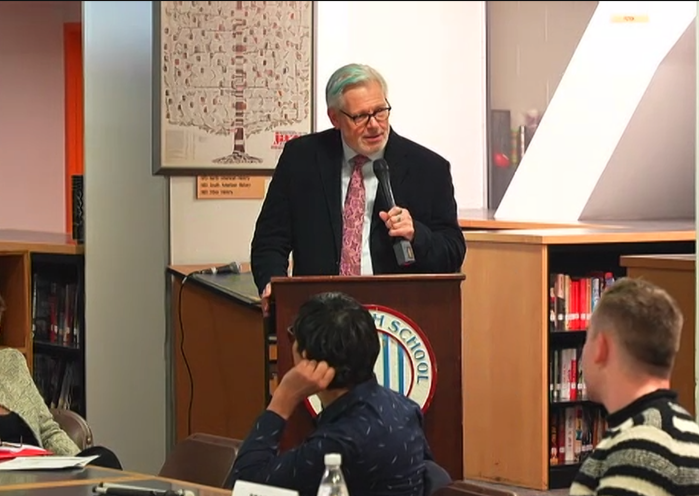Hans Bellmer’s Surrealist anatomies are all built on dolls
Hans Bellmer (1902 – 1975) was born in Germany but moved to Paris when Hitler came to power, and lived there for the rest of his life. Historically, Bellmer figures as one of the great Parisian Surrealists. He is best known for his photographic project entitled “La Poupée,” a psychologically intense body of work dating from the 1930s that became his obsession for 40 years.
Approximately 70 rare small prints from “La Poupée” are now on view at Ubu Gallery. Beautifully framed and installed, they have never been exhibited before. Many are contact prints or miniature versions of larger prints that Bellmer made as studies for handmade books. Several are mounted on colored card stock, and some are hand-painted in unusual, eerie color schemes. The exhibition continues in a gallery on the lower level with photographs of real people enacting “La Poupée”-esque pastimes. Larger vintage prints, many of them hand colored, are also on view. Don’t miss the display case holding some rare books about or made by Bellmer, including a copy of a collaborative project between himself and the Surrealist poet Paul Eluard entitled “Les Jeux de ‘La Poupée.’”
Bellmer began “Die Puppe” (“The Doll”) just before he left Germany in 1934. He constructed two adolescent female dolls out of wood and papier mâché based upon the design of toy dolls with moveable ball-joints. The ball-joint had great metaphysical meaning for his project. Bellmer’s artistic relationship with these life-size dolls and their constituent parts was most intense between 1934 and 1938, the period during which he photographed them. (“Die Puppe” became “La Poupée” when Bellmer moved to France.) Occasionally the dolls pose outdoors, but more often he pictured them in a domestic environment. They were constructed so that parts could be assembled, disassembled, recombined. One arrangement, for example, shows the two pairs of legs joined at the waist in one unusual unit, dressed in socks and shoes, reclining—as best it can—on a bed. When the head appears, the face is often shyly half hidden. The addition of roses in some of the images brought to mind “Ordeal by Roses,” a collaboration between the Japanese writer Yukio Mishima and the Japanese photographer Eikoh Hosoe. Bellmer and Hosoe both used straightforward, unmanipulated black and white photography to unravel rational consciousness and allow the unconscious to play in plain sight.
Bellmer worked in other media besides photography. An exhibition at the Pompidou Center in Paris this spring featured his oeuvre in depth, including rarely exhibited works such as the doll sculptures, drawings, paintings, graphics, and many unpublished notes. Curators Agnès de la Beaumelle and Alain Sayag noted that if Bellmer’s project began as a political protest, it moved on from any specific ties to world events toward an exploration of personality that is still highly relevant. Here in New York, a fine group of Bellmer’s works on paper and a few hand colored photos is on view at Miguel Abreu Gallery, 36 Orchard Street, through July 2.
Perhaps because Bellmer’s work so powerfully entertains the senses, his keen intellectual interest in the psychology and physiology of desire is too often overlooked. In effect, he experimented on himself through his work. “La Poupée” reflects his own fantasy, his own response, and his own analysis of desire, which the Surrealists often compared to a machine. Visually bruising, erotic, and in the end a philosophical experiment that defies categorization, “La Poupée” still bewitches her audience.
gaycitynews.com

